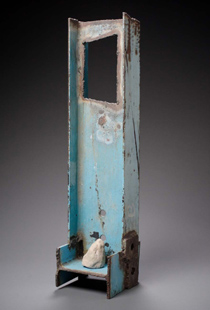“Every subatomic particle not only performs an energy dance, but also is an energy dance; a pulsating process of creation and destruction. The dance of Shiva is the dancing universe, the ceaseless flow of energy going through an infinite variety of patterns that melt into one another. For the modern physicists, then Shiva’s dance is the dance of subatomic matter…a continual dance of creation and destruction involving the whole cosmos; the basis of all existence and of all natural phenomenon.” ~ Fritjof Capra, The Tao of Physics: An Exploration of the Parallels between Modern Physics and Eastern Mysticism, pp. 241-245
 The Hindu deity Shiva, in his Nataraja manifestation, embodies both the destruction and creation of the cosmos. This great avatar dances in the subtle radioactive rays emitted by my office computer. Almost daily, I see this four-armed god, each arm representing a cardinal direction, under the monitor’s silver Dell logo. At only one and a half inches in height, he stands triumphant with his right foot atop the prostrate dwarf Apasmara Purusha, the demon of ignorance and illusion. His left leg is raised in the air, bent at the knee, and forcefully, yet gracefully pivots towards his right, propelling him in a clockwise direction.
The Hindu deity Shiva, in his Nataraja manifestation, embodies both the destruction and creation of the cosmos. This great avatar dances in the subtle radioactive rays emitted by my office computer. Almost daily, I see this four-armed god, each arm representing a cardinal direction, under the monitor’s silver Dell logo. At only one and a half inches in height, he stands triumphant with his right foot atop the prostrate dwarf Apasmara Purusha, the demon of ignorance and illusion. His left leg is raised in the air, bent at the knee, and forcefully, yet gracefully pivots towards his right, propelling him in a clockwise direction.
As Shiva Nataraja twirls with one revolution,* he fills his lungs with the fiery wind of his fierce spinning, ignited by the ball of flame thrown from his upper left hand. In so doing, he destroys the universe. Then, in the next revolution, he exhales ash from the universe just annihilated. And, with the beating drum held in his upper right hand, its rhythm and pulsating sound of OM from which all languages emerge, he gives birth to new and vast creations that feed on the extinguished inferno’s nutritious cinders—endless cycles of death, birth, and rebirth.
The King of the Cosmic Dance, with his lower left arm outstretched, points his hand towards his upraised left foot as a gesture to the release, or annihilation, of material bondage and the destruction of our imperfections, bad habits, and self-defeating attachments. Once overcome, the ensuing creation emerges, a transformed universe of beauty and wonder where divine qualities inherent in each individual are restored and opportunities for joy, peace, knowledge, and spiritual advancement are universally available.
Shiva Nataraja’s dance has been a poignant jig for me these past few months and why I’ve spent a bit of time on it here. I recently exhibited Spontaneous Memorial, an installation at the Springville Museum of Art designed to help us reflect on the significance of 9/11 and the ensuing ten years of war, continuing still. There has been much destruction during this decade with tens of thousands of lives lost and maimed and enough of the country’s treasure spent to easily thrust the nation into bankruptcy – morally and financially. I keep wondering when/if the “rejuvenation” cycle of Shiva’s cosmic reel kicks in?
* The duration of these cycles of decay and rejuvenation, which last hundreds of thousands of years each, is explained by my old spiritual master, His Divine Grace A.C. Bhaktivedanta Swami Prabhupada, in this purport about Lord Brahma: http://bhagavadgitaasitis.com/8/17/en1.
For information about how Spontaneous Memorial started, please refer to this pdf document. Reviews and other information are found here and in my posts for September/October 2010, March 2010, and October 2009.
Prior to installing Spontaneous Memorial, and between work as curator of Final Light: V. Douglas Snow in Retrospect, I exhibited:
- New prints, augmented with existing sculptural works, at Terra Nova Gallery in Provo (see here).
- Works from my reli ? QUERIES series at Nox Contemporary in Salt Lake City. Here are reviews. In conjunction with the exhibition, I published a chap book, The Destructible Object, with essays by Scott Abbott (see an example of the book shown here with Abbott’s essay titled: “The Other Side of the Limit” ), Alex Caldiero, Jay Heuman, David Gagon, and Geoff Wichert. It received an Arty Award from The City Weekly. What few books are left can be purchased through Ken Sanders Rare Books.
- Next year is starting to take shape. I’ve received an invitation by Nox Contemporary to curate an exhibition of works by a minimalist sculptor well known in the Rocky Mountain Region that I’ve titled, “When the Bronze Cools: Works by Neil Hadlock.”
- Another invitation came from my representative gallery, David Ericson Fine Art, for a solo exhibition in the fall.
- I’m still hoping to move my studio to the two conjoining bays at the end of the building, doubling my work space. I don’t intend, however, to give up the semi-trailer behind the building used for storage, just off the loading dock. It’s difficult for me to make works from found objects if I can’t find them in the chaos of studio life. More space will help keep a modicum of order.
- Most importantly, foundational to all of my work is the support I receive from Marjorie and our five children and their families and the encouragement, ideas, and flack from a great bevy of friends.








